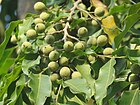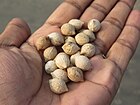Note: This is a project under development. The articles on this wiki are just being initiated and broadly incomplete. You can Help creating new pages.
Difference between revisions of "Putranjiva roxburghi - Putranjiva"
(→References) |
(→External Links) |
||
| Line 90: | Line 90: | ||
[[Category:Herbs]] | [[Category:Herbs]] | ||
| − | [[Category:Plants of western ghats]][[Category: | + | [[Category:Plants of western ghats]][[Category:Euphorbiaceae]] |
Revision as of 10:28, 27 May 2019
Putranjivah is an evergreen tree with graceful hanging branches and dark green leaves. Its seeds have long been used in Ayurveda.
Contents
- 1 Uses
- 2 Parts Used
- 3 Chemical Composition
- 4 Common names
- 5 Properties
- 6 Habit
- 7 Identification
- 8 List of Ayurvedic medicine in which the herb is used
- 9 Where to get the saplings
- 10 Mode of Propagation
- 11 How to plant/cultivate
- 12 Commonly seen growing in areas
- 13 Photo Gallery
- 14 References
- 15 External Links
Uses
Aphrodisiac, Gastritis, Burning sensation in eyes, Relieves thirst [1]
Parts Used
Chemical Composition
Common names
| Language | Common name |
|---|---|
| Kannada | Amaami, Amani, Kaal damani, Menasina kaale, Putranjeeva |
| Hindi | Jiaputa, Jivputrak, Jiyapota, Putranjiva |
| Malayalam | Pongolan, Ponkalam, Putranjivi, Puttilanni |
| Tamil | Karuppilai, Kattuppacceri Maram, Pongolam |
| Telugu | Kadrajuvi, Kudrajinic, Kudurujuvir, Kudurujuvvi, Putra jeevi |
| Marathi | NA |
| Gujarathi | NA |
| Punjabi | NA |
| Kashmiri | NA |
| Sanskrit | Aksaphala, Kumarbeeja, Putrajivah, Putranjiva |
| English |
Properties
Reference: Dravya - Substance, Rasa - Taste, Guna - Qualities, Veerya - Potency, Vipaka - Post-digesion effect, Karma - Pharmacological activity, Prabhava - Therepeutics.
Dravya
Rasa
Madhura (Sweet), Katu (Pungent)
Guna
Guru (Heavy), Picchila (Slimy)
Veerya
Sheeta (cold)
Vipaka
Karma
Pitta, Vata
Prabhava
Habit
Identification
Leaf
| Kind | Shape | Feature |
|---|---|---|
| Simple | alternate | stipule small, lateral, caducous; petiole 5-7 mm long, slender, pubescent; lamina 3.5-12 x 1.5-4.5 cm, elliptic-oblong, base oblique, apex shortly acuminate, acute or obtuse with retuse tip; margin serrate or serrulate, glabrous, dark green, shining, coriaceous; lateral nerves 8-12 pairs, pinnate, slender, ascending, prominent, intercostae reticulate, slender, prominent. |
Flower
| Type | Size | Color and composition | Stamen | More information |
|---|---|---|---|---|
| Unisexual | axillary spikes | yellow | Flowers unisexual, small, yellow; male flowers: sessile, in axillary spikes, 2-2.5 mm across; pedicels 1.5-2 mm long, glabrous; tepals 3-5, oblong, puberulous without, ciliate, obtuse, imbricate; stamens 2-4, 1.5-2 mm long; filaments thick, more or less connate towards base; anthers ovate, hairy; female flowers: solitary or in 2 or 3, axillary; pedicel upto 15 mm long, puberulous; bracts lanceolate; tepals 5-6, 2-2.5 × 1-1.5 mm, unequal, oblong, puberulous without, ciliate, acute; ovary superior, 3 x 2.5 mm, globose, tomentose, 3-celled, ovules 2 in each cell; style 3, spreading, tomentose, often connate below into dilated into broad fleshy stigma; stigma crescent-shaped, glandular. |
Fruit
| Type | Size | Mass | Appearance | Seeds | More information |
|---|---|---|---|---|---|
| A drupe | 1.3-2 x 1.5 cm | ovoid-ellipsoid, white tomentose; seed one, crustaceous; pedicels 6-25 mm long. | {{{5}}} | {{{6}}} |
Other features
List of Ayurvedic medicine in which the herb is used
Where to get the saplings
Mode of Propagation
How to plant/cultivate
Season to grow
Soil type
Propagation
Commonly seen growing in areas
Tropical area, Sub Tropical area
Photo Gallery
References
External Links
Categories:
- Ayurvedic Herbs known to be helpful to treat Aphrodisiac
- Ayurvedic Herbs known to be helpful to treat Gastritis
- Ayurvedic Herbs known to be helpful to treat Burning sensation in eyes
- Ayurvedic Herbs known to be helpful to treat Relieves thirst
- Herbs with Seeds used in medicine
- Herbs with Leaves used in medicine
- Herbs with common name in Kannada
- Herbs with common name in Hindi
- Herbs with common name in Malayalam
- Herbs with common name in Tamil
- Herbs with common name in Telugu
- Herbs with common name in Sanskrit
- Habit - Tree
- Index of Plants which can be propagated by Seeds
- Index of Plants which can be propagated by Cuttings
- Herbs that are commonly seen in the region of Tropical area
- Herbs that are commonly seen in the region of Sub Tropical area
- Herbs
- Plants of western ghats
- Euphorbiaceae




